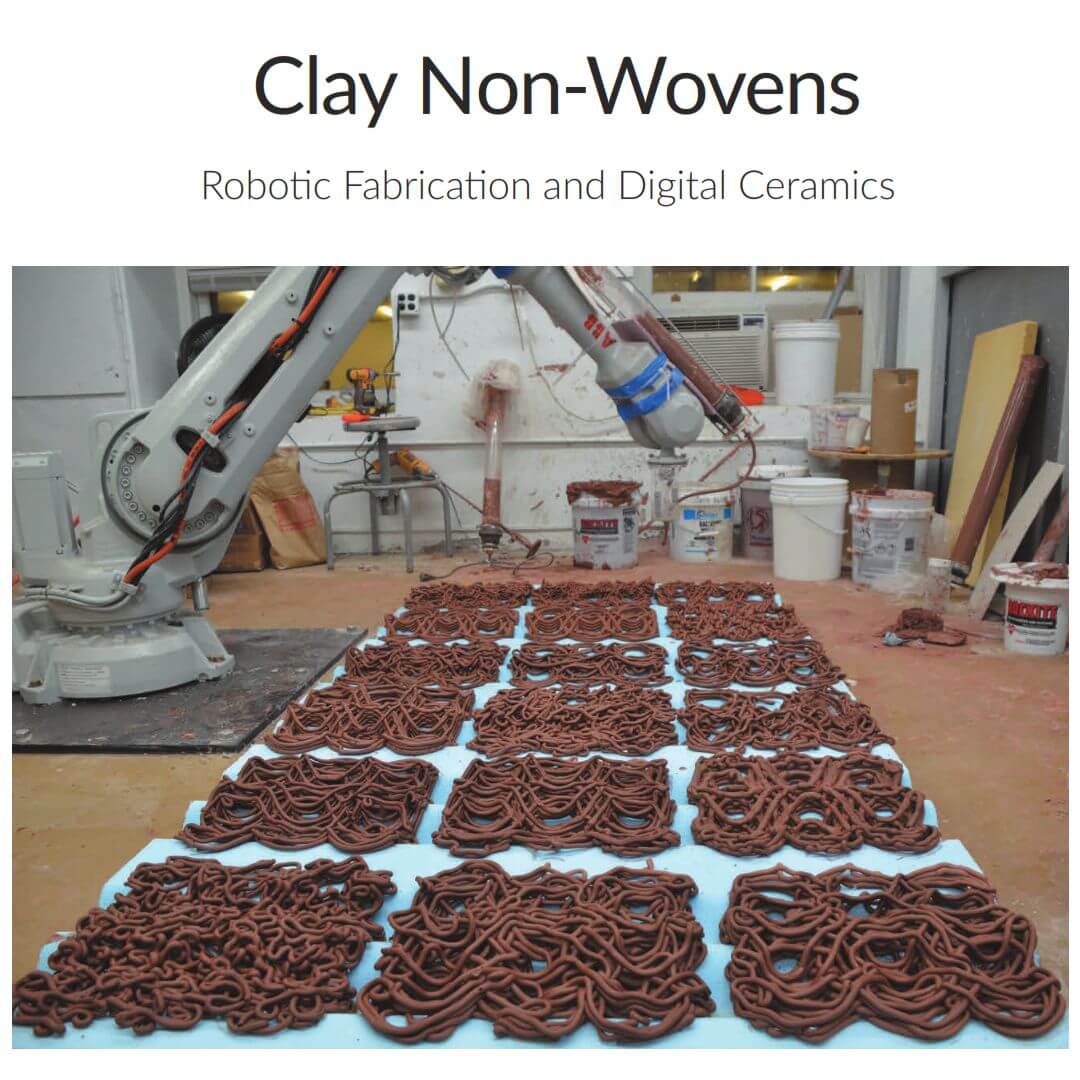Digital Ceramics
Clay Non-Wovens:
Robotic Fabrication and Digital Ceramics
David Rosenwasser, Sonya Mantell, Jenny Sabin
Dept. of Architecture, AAP, Cornell University & Sabin Design Lab, AAP, Cornell University
Clay Non-Wovens develops a new approach for robotic fabrication, applying traditional craft methods and materials to a fundamentally technical and precise fabrication methodology. This paper includes new explorations in robotic fabrication, additive manufacturing, complex patterning, and techniques bound in the arts and crafts.
Clay Non-Wovens seeks to develop a system of porous cladding panels that negotiate circumstances of natural daylighting through parameters dealing with textile (woven and non-woven) patterning and line typologies. While additive manufacturing has been built predominantly on the basis of extrusion, technological developments in the field of 3D printing seldom acknowledge the bead or line of such extrusions as more than a nuisance.
 Blurring of recognizable layers is often seen as progress, but it does away with visible traces of a fabrication process. Historically, however, construction methods in architecture and the building industry have celebrated traces of making ranging from stone cutting to log construction.
Blurring of recognizable layers is often seen as progress, but it does away with visible traces of a fabrication process. Historically, however, construction methods in architecture and the building industry have celebrated traces of making ranging from stone cutting to log construction.
With growing interest in digital craft within the fields of architecture and design, we seek to reconcile our relationship with the extruded bead and reinterpret it as a fiber and three-dimensional drawing tool. The traditional clay coil is to be reconsidered as a structural fiber rather than a tool for solid construction.
Building upon this body of robotically fabricated clay structures required the development of three distinct but connected techniques: 1. Construction of a simple end effector for extrusion; 2. Development of a clay body and; 3. Using computational design tools to develop formwork and toolpath geometries.
 The craft of ceramics, dating back many millennia, has appealed to artisans and artists alike due to its workable plasticity, but also because of its unpredictable formal characteristics. The clay medium can be controlled and standardized for brick-making as an example, but that requires both consistent formwork and wall thickness.
The craft of ceramics, dating back many millennia, has appealed to artisans and artists alike due to its workable plasticity, but also because of its unpredictable formal characteristics. The clay medium can be controlled and standardized for brick-making as an example, but that requires both consistent formwork and wall thickness.
When this consistency varies or a form does away with uniformity, the material has the tendency to warp, move, and sometimes crack in spontaneous ways. Put in the context of digital fabrication, the material adds a series of parameters based more so in craft, which can be honed, refined, and learned, as we’ve seen in Hod Lipson’s work with robots and painting.
 Additive manufacturing typically involves the construction of objects through the continuous deposition of material, which builds up to form solid surfaces. The process of deposition allows the freedom to create a surface with possibilities for voids formed by absences.
Additive manufacturing typically involves the construction of objects through the continuous deposition of material, which builds up to form solid surfaces. The process of deposition allows the freedom to create a surface with possibilities for voids formed by absences.
Less common point-based additive manufacturing is also used, where cellular structures are constructed to build lightweight forms, still recognizable by their defined shapes or bounding lines. Subtractive processes, such as CNC (computer numerical control) machining, allow for the manipulation of nearly any solid material, but can be severely restricted by reductive limitations such as undercuts and scale.
 More recent explorations engage structural bone formation and programmable matter through DNA glazing, but all using powder-based or stereolithography technology. By shifting upward in scale to the fabrication capabilities provided by a 6-axis robotic arm, and also increasing scale and attention to each individual layer, we dramatically shift this focus of the nonstandard to address nonstandard patterning in conjunction with mass customizable forms.
More recent explorations engage structural bone formation and programmable matter through DNA glazing, but all using powder-based or stereolithography technology. By shifting upward in scale to the fabrication capabilities provided by a 6-axis robotic arm, and also increasing scale and attention to each individual layer, we dramatically shift this focus of the nonstandard to address nonstandard patterning in conjunction with mass customizable forms.




























Comments